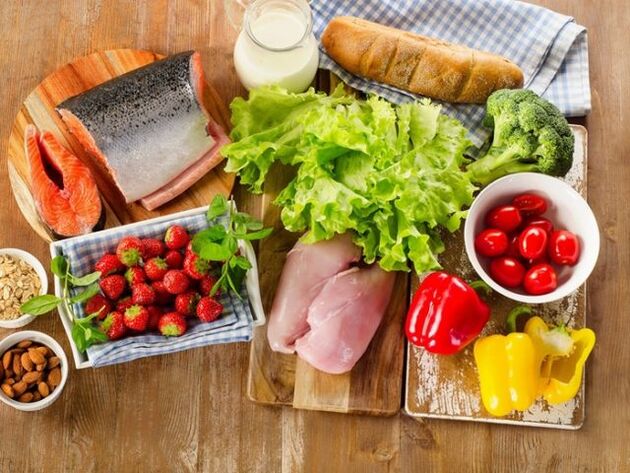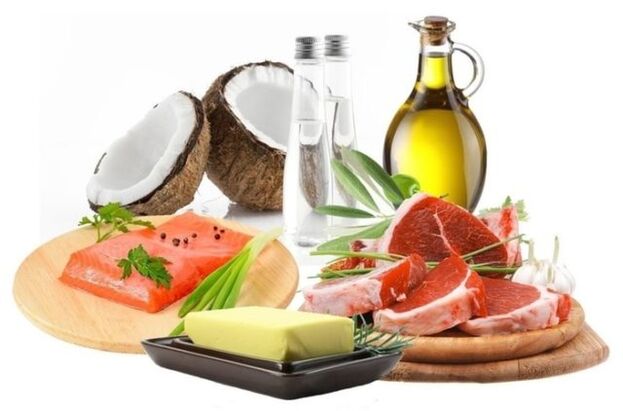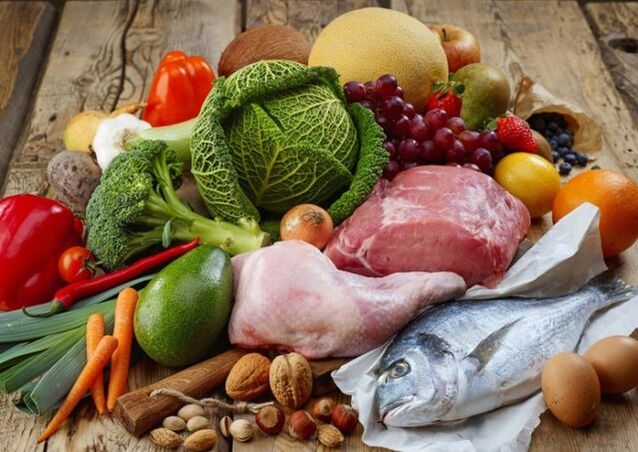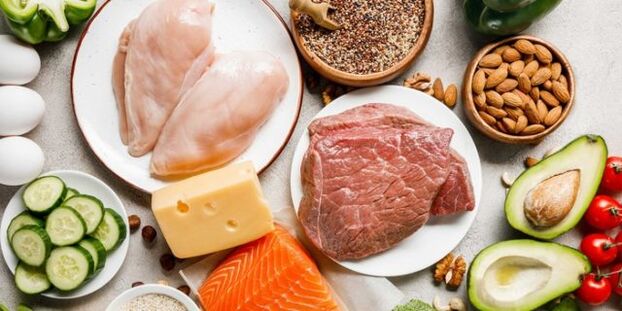Today, one of the most fashionable and common ways to lose weight is the ketogenic diet. It is noteworthy that if this diet is followed, one does not starve but eats fatty and high calorie foods. The positive effect is achieved by limiting the amount of carbohydrates consumed and actually reducing their use in food to zero.
ketogenic diet
Researchers are proving that a ketogenic diet helps with diseases such as: epilepsy, multiple sclerosis, autism, Alzheimer's disease, cancer.

This diet is a type of low carb diet where when the body does not get carbs from food, it is forced to spend fats to get energy. In this case, the fat burning process is very efficient. Metabolic changes or ketosis, when ketone bodies get directly into the brain, the body uses energy.
This diet lowers blood sugar and insulin levels, so this diet is also prescribed for diabetics, but only in type 2 diabetes.
Rules of the ketogenic diet
Adhering to a ketogenic diet should follow some simple rules and recommendations, only then can a positive result be achieved as soon as possible.
- One of the main principles of a ketogenic diet is to drink plenty of fluids daily - at least 3-4 liters.
- With the exception of main meals, snacks during the day should be excluded.
- In addition to a ketogenic diet, active exercise is recommended.
- The amount of protein ingested should be gradually reduced to 1. 5 g per 1 kg.
- The level of carbohydrates consumed per day should also be gradually reduced, ultimately not exceeding 20 g per day.
- The main energy source in the keto diet is fat, so don’t worry about consuming it.

Approved products
After a ketogenic diet, you can eat the following foods:
- Seafood - squid, oysters, crabs, lobster, mussels and clams.
- Fish - salmon, cod, catfish, halibut, mackerel, trout, tuna, flounder. You can eat the fish in any form - fried, steamed, cooked and baked in the oven.
- Meat - beef, pork, rabbit, poultry, veal. Like fish, meat can be used in any form - you can cook loin, roasts, steaks, all you have to do is make the sirloin thicker.
- Chicken and quail eggs, which can be eaten fried and cooked.
- The viscera - the liver, stomach, tongue, heart and lungs are among the main sources of nutrients.
- Sausages - bacon, ham, sausages. When buying these products, read the composition carefully to avoid additives and sugar.
- Raw cheeses - goat, cream, mozzarella, cheddar.
- Healthy oils are natural olive and coconut oils. You can also eat avocado oil.
- Walnuts - peanuts, walnuts and pine nuts, cashews, almonds, pumpkin and flax seeds, hazelnuts.
- Vegetables - all green vegetables are low in starch and carbohydrates, in addition to onions and tomatoes.
- Butter and cream.
- Strawberry.
- You can drink green tea, weak black tea, non-carbonated mineral water or boiled water.
Prohibited products
The following foods should not be consumed during a ketogenic diet:
- Products with a high sugar content: juices, drinks, sweets, cakes, jams, sweet cakes, ice cream, marshmallows.
- Foods containing cereals and starch: Pastries made from wheat flour, bread, cereals, rice and pasta.
- All kinds of fruit.
- All kinds of legumes.
- Tubers and roots: parsnips, carrots, potatoes, Jerusalem artichokes.
- Dietary and low-fat products - go through several processing stages, which can result in excessive amounts of carbohydrates.
- Sauces such as ketchup and mayonnaise as they contain sugar and unhealthy fats.
- Unhealthy fats, the main sources of which are margarine and processed vegetable oil, should therefore be excluded from the diet, or at least reduced.
- Alcoholic products. Many alcoholic beverages contain large amounts of carbohydrates, so using them can nullify all diets.
- Dietary foods without sugar. Such products are usually highly processed and filled with harmful chemical elements.
Before starting a ketogenic diet, consult a specialist, as the list of permitted and prohibited foods may vary from patient to patient, depending on the individual characteristics of the human body.
Ketogenic diet: weekly menu
The approximate weekly menu for those following a ketogenic diet is as follows.
Monday
- Breakfast. Eggs and cheese.
- Lunch. Cottage cheese with cream.
- Dinner. Chicken breast, cheese and brown rice.
- afternoon tea. Cheese and some nuts.
- Dinner. Vegetable salad, fish in any form, garnished with brown rice.

Tuesday
- Breakfast. Omelette, ½ grapefruit, spinach.
- Lunch. Cottage cheese.
- Dinner. Vegetable salad, chicken breast, cheese.
- afternoon tea. Cottage cheese.
- Dinner. Steak with brown rice and salad with vegetables.
Wednesday
- Breakfast. Omelette with homemade yogurt.
- Lunch. Cheese, nuts.
- Dinner. Chicken breast with broth and salad.
- afternoon tea. Kefir, fruit.
- Dinner. Fish, lettuce, brown rice.
Thursday
- Breakfast. Cheese, boiled egg, orange.
- Lunch. Homemade kefir.
- Dinner. Broth, brown rice.
- afternoon tea. Cheese, almonds.
- Dinner. Hal, broccoli.
Friday
- Breakfast. Boiled eggs with salsa.
- Lunch. Bacon or ham.
- Dinner. Meat casserole with vegetables and mushrooms and salad.
- afternoon tea. Kefir with salad.
- Dinner. Chicken breast with rice
Saturday
- Breakfast. Omelette with salad.
- Lunch. A cheese sandwich.
- Dinner. Offal soup, fish.
- afternoon tea. Cheese, hazelnuts.
- Dinner. Pork steak on toast.
Sunday
- Breakfast. Fried eggs, oatmeal or millet porridge.
- Lunch. Kefir and fruit.
- Dinner. Vegetable soup with meat and chicken breast.
- afternoon tea. Kefir and boiled beef.
- Dinner. Fish, lettuce, brown rice, cheese.
Advantages and disadvantages of this diet
There are several pros and cons to following a ketogenic diet that need to be considered before starting such a diet.
Advantages:
- The diet is fairly easily tolerated because one does not starve when observed.
- Consuming small amounts of carbohydrates reduces insulin production, thus preventing the risk of developing cardiovascular disease.
Cons:
- Uncontrolled adherence to a ketogenic diet results in a decrease in blood acidity, which in turn can lead to ketoacidosis, which in most cases results in the death of the patient. However, this phenomenon is quite rare, especially in diabetics.
- The condition of ketosis is dangerous to human health, as in this case the load on the kidneys increases significantly, so there is a risk of developing urolithiasis and osteoporosis.
- It is impossible to follow this diet for a long time as a person begins to have digestive problems - constipation and nausea due to constant consumption of fatty foods.

Contraindications
It is impossible to follow a ketogenic diet for disorders such as: cardiovascular disease, liver and kidney disease, diabetes, metabolic disorders, progressive encephalopathy.
Before starting a ketogenic diet, consult a professional, weigh the pros and cons, and prepare for it. You should consult your doctor regularly and strictly follow all of your recommendations to avoid unpleasant consequences while following your diet.































